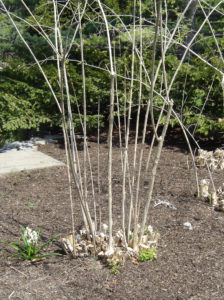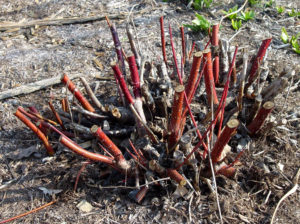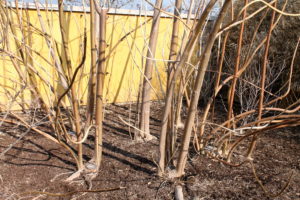Why Would You Want to Cut a Plant Almost to the Ground?
March 19th, 2019
Gardeners have to overcome erratic weather, sidestep a laundry list of potential bug and disease threats, and beat back attacks by deer, voles, and groundhogs to grow a decent plant.
So why would any sane gardener ever consider cutting a healthy tree or shrub to the ground?
I can think of a few good reasons for what horticulture calls “coppicing.”
The main reason is to rejuvenate a big, old bush. Getting rid of all of the old wood clears space and coerces a plant to get busy growing fresh shoots – or else.
Another is that coppicing turns what wants to be a jungle-sized plant into one whose size fits the space you have.
And a third reason is that for some plants, their one- or two-year-old wood is a brilliant red or gold, fading to gray or brown with age. By constantly whacking the older wood, you produce a steady stream of young wood, resulting in a better-looking plant.

The new shoots of red-twig dogwoods are the most colorful, fading to grown and gray once they’re 3 or 4 years old.
You can’t coppice everything, though. Trees that are generally grown as single-trunk plants, for example, don’t respond well to a near total cutback. Coppice an oak, maple, or most any evergreen, and you’ll find yourself looking at a lifeless stump.
Some species push up some weak, leggy, half-hearted new shoots after coppicing – enough to keep the plant alive but a far cry from the first-generation effort.
But some woody species – especially ones that grow as multi-stemmed flowering shrubs – will roar back better than ever.
Probably the best known coppice-worthy shrubs are the red-twig and gold-twig dogwoods. Several species of these 5- to 6-foot bushy shrubs respond nicely to being cut back to 3- or 4-inch stubs at the end of each winter.
These dogwoods produce their brightest red or gold stems on new wood. Let them unpruned, and little by little, new shoots dwindle, and the aging stems turn grayish-brown.
For size control, a good plant to coppice every year or two is the purple smoke bush, which will quickly become a purple smoke tree if you don’t cut it.
A near decapitation in March will create a 6-foot shrub with vibrant purple-burgundy leaves instead of a 20-footer with duller purple-brown summer leaves and a floppy, gangly habit. The tradeoff is that with coppicing, you won’t get any/many of the plant’s rounded, “puffy-smoke-ball” flowers.
The variegated-leaf dappled or tricolor willow (Salix integra ‘Hakuro-nishiki’) is another plant whose leaves look much better on new wood.
Let the plant alone, and it gets rangy with green leaves. Coppice it each March before new growth begins, and you get a 6-foot shrub with nearly white foliage in spring.
Scott Arboretum at Swarthmore College showed how effective coppicing can be in taming an otherwise over-exuberant tree called paulownia.
Paulownia (sometimes nicknamed “empress tree”) is one of the fastest growing trees on Earth. It can grow up to 15 feet in a single year – quickly dominating a typical yard.
Scott treats paulownias as cutback shrubs, whacking them nearly to the ground each year. The roots send up shoots that grow 10 or 12 feet that season, producing bigger leaves than usual for a tropical look at an eye-grabbing but not towering height.
When it comes to aging lilacs, coppicing yields the quickest turn-around. Lilacs often peter out in the bloom department and become more susceptible to powdery mildew as they age.

All but the first-year growth of this beautybush has been cut to the ground to rejuvenate the plant.
A good way to prevent that is by removing one-third of the biggest, oldest shoots to the ground immediately after the plant finishes blooming each May. Allow an equal number of new shoots to replace the cut ones. Do this each year, and you’ll have the equivalent of a new shrub every fourth year.
The quicker way to get to that new lilac is by cutting everything to a 3- to 4-inch stub right after bloom. The new growth will be skinnier and shorter, but the bloom probably will be much better the following May.
I once rejuvenated a gangly ninebark that was getting hammered by powdery mildew.
The year after I cut the whole thing almost to the ground and got rid of all of the fallen diseased leaves, I had clean foliage and a more compact habit. It was like a new plant again.
Sweetspires, rose-of-sharons, butterfly bushes, beautybushes, forsythia, and elderberries are other woody plants you can rejuvenate by coppicing if they’re getting too dense, developing leaf disease, or just getting too big.
In cold winters, the weather might force you to coppice. Sometimes the cold will kill all or most of the top growth of borderline-hardy woody plants, such as crape myrtles, figs, vitex, and sometimes butterfly bushes and big-leaf hydrangeas.
If you’re going to coppice, the ideal time is end of winter – right before new growth happens.
The other doable time in the case of spring-blooming shrubs is right after they bloom. This lets you enjoy that season’s flowers, but the tradeoff is that the plant has to grow two sets of leaves in one year, which is energy-draining.
Watering, fertilizing, and topping the ground with an inch of compost after coppicing is a good strategy for helping a plant bounce back from beheading.









